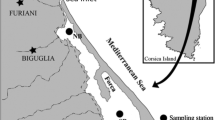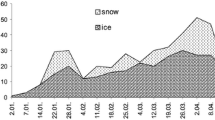Abstract
The energy contents (standing stock) of the floating mat formed by the green alga Cladophora sivaschensis and the energy transfers through it were quantified for a shallow hypersaline lake (at Cape Khersones, Crimea, Ukraine) during the spring months. Appropriate direct calorimetric techniques were applied to: (i) measure the heat energy dissipated by the mat community and by the free bacterioplankton in the water column below it; and (ii) differentiate between the heat flows by the heterotrophic and the phototrophic components of the community. It was shown that Cladophora biomass reached a peak of 579.5 g C m–2, contributing more than 99.6% of the total mat community. Throughout the spring, the total bacterial energy transfer (6 to 23 mW m–2) was as little as 1.1 to 2.6% of the total heat dissipated by the microplankton community. The rest of the estimated heat energy (584 to 1488 mW m–2) was associated with Cladophora metabolism. In the spring community: (i) the rate of biomass accumulation in the lake photic layer significantly exceeded its heterotrophic mineralisation; (ii) the efficiency of the microbial loop was too low to process even a minor part of the accumulated organic matter. The microcalorimetric technique was shown to be a highly promising approach for further studies of natural microbial mats and biofilms, biological systems with complex metabolism that involves not only aerobic processes but also anaerobic catabolism under local hypoxic/microxic conditions.
Similar content being viewed by others
References
Bratbak G. and Dundas I. 1984. Bacterial dry matter content and biomass estimations. Appl. Environ. Microbiol. 48: 1488–1493.
Caron D.A., Goldman J.C., Andersen O.K. and Dennett M.R. 1985. Nitrogen cycling in a microflagellate food chain: II. Population dynamics and carbon cycling. Mar. Ecol. Prog. Ser. 24: 243–254.
Caron D.A., Goldman J.C. and Fenchel T. 1990. Protozoan respiration and metabolism. In: Capriulo G.M. (ed.), Ecology of Marine Protozoa. Oxford University Press, Oxford, UK, pp. 307–322.
Cayol J.L., Ollivier B., Patel B.K.C., Ageron E., Grimont P.A.D., Prensier G. and Garcia J.L. 1995. Haloanaerobium lacusroseussp. nov., an extremely halophilic fermentative bacterium from the sediments of a hypersaline lake. Int. J. Syst. Bacteriol. 45: 790–797.
Chepurnova E.A., Shumakova G.V. and Buchakchiyskaya A.N. 1988. Size spectra of marine bacterioplankton as measured on the Synpor ultramembranes # 6 and 7. Microbiologia 57: 146–151. (in Russian)
Chepurnova E.A., Shumakova G.V. and Gutveyb L.G. 1993. —Bacterioplankton.. In: Plankton of the Black Sea (Plankton Chyornogo moray). Naukova Dumka, Kiev (in Russian), pp. 110–142.
Dodds W.K. and Gudder D.A. 1992. The ecology of Cladophora. J. Phycol. 28: 415–427.
Duboc P., Marison I. and von Stockar U. 1999. Quantitative calorimetry and biochemical engineering. In: Gallagher P., Handbook of Thermal Analysis and Calorimetry, Vol. 4, Kemp RB (ed.), From macromolecules to man. Ch.6 pp. 267–365. Elsevier, Amsterdam, The Netherlands.
Gnaiger E. 1993. Nonequilibrium thermodynamics of energy transformations. Pure. Appl. Chem. 65: 1983–2002.
Gnaiger E. and Kemp R.B. 1990. Anaerobic metabolism in aerobic mammalian cells: information from the ratio of calorimetric heat flux and respirometric oxygen flux. Biochim. Biophys. Acta. 1016: 328–338.
Haas L.W. 1982. Improved epifluorescence microscopy for observing planktonic microorganisms. Ann. Inst. Oceanogr. 58: 261–266.
Hesselink van Suchtelen F.A. 1931. Energetics and microbiology of the soil. Arch Pflanzenbau 7: 519–541.
Hobbie J.E., Daley R.J. and Jasper S. 1977. Use of Nucleopore filters for counting bacteria by fluorescence microscopy. Appl. Environ. Microbiol. 33: 1296–1307.
Holter H. and Zeuthen E. 1949. Metabolism and reduced weight in starving Chaos chaos. CR Lab Carlsberg, Ser. Chim. 26: 277–296.
Ivanova M.B., Balushkina E.B. and Basova S.L. 1994. Structuralfunctional reorganization of ecosystem of the hyperhaline lake, Saki (Crimea). Russ J. Aquat. Ecol. 3: 111–126.
Johansson P. and Wadsö I. 1997. A photomicrocalorimetric system for studies of plant tissue. J. Biochem. Biophys. Methods. 35: 103–114.
Kemp R.B. 1998. Nonscanning Calorimetry.. In: Gallagher P., Handbook of Thermal Analysis and Calorimetry, Vol. 1, Brown M. (ed.) (ed.), Principles and Practice. Ch. 14. Elsevier, Amsterdam, The Netherlands, pp. 577–675.
Kemp R.B. 2000. Heat flux and the calorimetric-respirometric ratio as on-line probes of the metabolism in animal cells cultured in a bioreactor. Res. Adv. Biotechnol. Bioeng. 1: 37–65.
Kemp R.B. and Guan Y.H. 1999. Microcalorimetric studies of isolated animal cells. In: Gallagher P. (ed.), Handbook of Thermal Analysis and Calorimetry, Vol. 4, Kemp R.B. (ed.), From macromolecules to man. Ch. 11. Elsevier, Amsterdam, The Netherlands, pp. 557–656.
Kirchman D.L. 1993. Statistical analysis of direct counts of microbial abundance. In: Kemp P.F., Sherr B.F., Sherr E.B. and Cole J.J. (eds), Handbook of Methods in Aquatic Microbial Ecology. Lewis Publishers, Boca Raton, Florida, USA, pp. 117–120.
Kleiber M. 1932. Body size and metabolism. Hilgardia 6: 315–353.
Kleiber M. 1961. The Fire of Life: An introduction to animal energetics. John Wiley and Sons, New York, New York, USA.
Krumbein W.E. and Stal L.J. 1991. The geophysiology of marine cyanobacterial mats and biofilms. Kieler Meeresforsch Sonderh 8: 137–145.
Larsson C. and Gustafsson L. 1999. Calorimetry of microbial processes.. In: Gallagher P., Handbook of Thermal Analysis and Calorimetry, Vol 4, Kemp R.B. (ed.), From macromolecules to man. Ch 11. Elsevier, Amsterdam, The Netherlands, pp. 367–404.
Matsumoto G.I. 1989. Biogeochemical study of organic substances in Antarctic lakes. Hydrobiologia 172: 265–289.
Minicheva G.G. and Zotov A.B. 2003. Feature of dynamics of specific surface of phytoplankton populations from Odessa region (the Black Sea). Ekologia Morya 63: 46–52. (in Russian)
Mukhanov V.S., Kirin M.P. and Polikarpov I.G. 2001. The growth and grazing kinetics in heterotrophic bacteria inhabiting planktonic aggregates estimated by the dilution method. Ekologia Morya 55: 45–49. (in Russian)
Mukhanov V.S., Rylkova O.A., Lopukhina O.A. and Kemp R.B. 2003. Productivity and thermodynamics of marine bacterioplankton: an inter-ecosystem comparison. Thermochim. Acta. 397: 31–35.
Norland S. 1993. The relationship between biomass and volume of bacteria. In: Kemp P.F., Sherr B.F., Sherr E.B. and Cole J.J. (eds), Handbook of Methods in Aquatic Microbial Ecology. Lewis Publishers, Boca Raton, Florida, USA, pp. 303–308.
Núñez-Regueira L., Núñez-Fernández O., Rodríguez Añón J.A. and Proupín Castiñeiras 2002. The influence of some physicochemical parameters on the microbial growth in soils. Thermochim. Acta. 394: 123–132.
Padan E. 1989. Combined molecular and physiological approach to anoxygenic photosynthesis of cyanobacteria. In: Cohen Y. and Rosenberg E. (eds), Microbial Mats: Physiological Ecology of Benthic Microbial Communities. Kluwer, Dordrecht, Netherlands, pp. 277–282.
Pamatmat M.M. 2003. Heat-flow measurements in aquatic ecosystems. J. Plankton Res. 25: 461–464.
Pamatmat M.M., Graf G., Bengtsson W. and Novak C.S. 1981. Heat production, ATP concentration and electron transport activity of marine sediments. Mar. Ecol. Prog. Ser. 4: 135–143.
Peckol P. and Rivers J.S. 1995. Physiological responses of the opportunistic macroalgae Cladophora vagabunda(L.) van den Hoek and Gracilaria tikvahiae(McLachlan) to environmental disturbances associated with eutrophication. J. Exp. Mar. Biol. Ecol. 190: 1–16.
Petrov V.E. 1975. Energetics of the assimilating cell and photosynthesis Kazan University Press, Kazan, Russia (in Russian).
Post F.J. and Stube J.C. 1988. A microcosm study of nitrogen utilization in the Great Salt Lake, Utah. In: Melack J.M. (ed.), 3rdInt Symp on Inland Saline Lakes, Nairobi (Kenya), 28-31 Aug 1985, Saline Lakes, 158: 89–100.
Senicheva M.I. 1990. Characteristic of phytoplankton as an object of nutrition for mussels Mytilus galloprovincialisLam. in the region of the marine farm of Laspi Bay. Ekologia Morya 36: 7–16. (in Russian)
Shadrin N.V., Zagorodnyaya YuA, Nevrova E.L., Naidanova O.G. and Senicheva M.I. 2001. Hydroecological system of Bakalskaya spit (Crimea): Problems of investigation and preservation of the unique biodiversity. Hydrobiologia 3: 168–170. (in Russian)
Spink C. and Wadsö I. 1976. Calorimetry as an analytical tool in biochemistry and biology. In: Glick D. (ed.), Methods in Biochemical Analysis. Vol. 23, Wiley-Interscience, New York, New York, USA, pp. 1–76.
Strathmann R.R. 1967. Estimating the organic carbon content of phytoplankton from cell volume or plasma volume. Limnol. Oceanogr. 12: 411–418.
Tornblom E. 1995. Microbial activity and biomass in aquatic surface sediments: A community level approach. PhD thesis, Inst. of Limnol, Uppsala University, Sweden.
Author information
Authors and Affiliations
Rights and permissions
About this article
Cite this article
Mukhanov, V.S., Naidanova, O.G., Shadrin, N.V. et al. The spring energy budget of the algal mat community in a Crimean hypersaline lake determined by microcalorimetry. Aquatic Ecology 38, 375–385 (2004). https://doi.org/10.1023/B:AECO.0000035169.08581.10
Issue Date:
DOI: https://doi.org/10.1023/B:AECO.0000035169.08581.10




